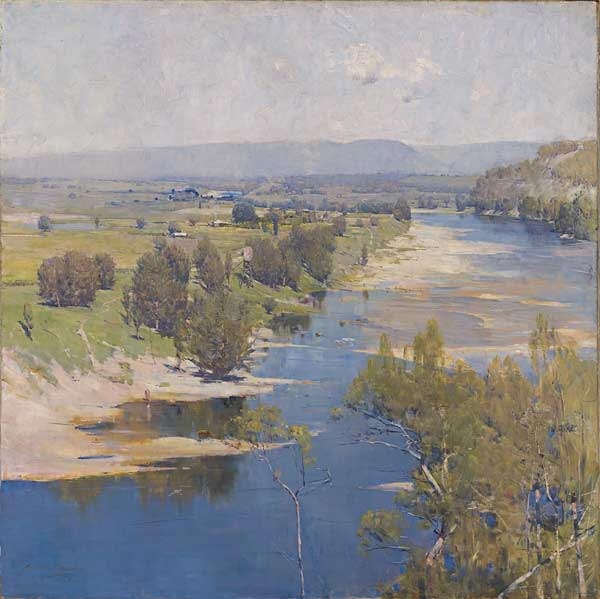
In this series, noted painter Joseph McGurl discusses plein air paintings by past masters that he finds instructive or inspiring. This week: Sir Arthur Streeton’s “The Purple Moon’s Transparent Might.”
Sir Arthur Streeton (1867-1943) is one of Australia’s most admired artists and was recognized for his contributions to the legacy of Australian art by being knighted in 1937. He was a member of the Heidelburg School, a group of dedicated plein air painters often painting in the Heidelburg area near Melbourne. Streeton painted “The Purple Noon’s Transparent Might” from under a tent over a period of two days of intense heat.
The effect of this heat is palpable. The vantage point and time of day chosen by the artist shows us the landscape in full sun; there are few areas of shadow to escape the sunlight. The colors are bright and intense in the foreground, gradually becoming modified by the atmospheric perspective moving into the distance. As well as portraying meteorology, Streeton gives a wonderful sense of space. Although it is a square canvas, there is a panoramic quality to the scene that is accomplished through the exploitation of linear perspective. In the foreground, most of the lines and shapes are vertical or diagonal; however, moving into the distance, they become increasingly horizontal. This leads the eye on an interesting journey from an up-and-down motion in the foreground to a completely side-to-side motion in the distance where we can imagine the plain extending beyond the picture frame. Ultimately, this change in motion gives the panoramic effect usually seen in horizontal compositions.
Because of the canvas’s large size, Streeton was able to give the impression of a great deal of detail and rendering. However, looking closely, he is quite economical and suggestive in his brushmarks. Most of the painting consists of color spots, but throughout the painting, there are minor accents that prevent the painting from becoming weak and formless. Though there is actually very little descriptive painting, by choosing just the right color, value, and shape, Streeton could paint less and convey a complete statement.
Streeton is also economical in his color range, creating a beautiful color harmony with just a few colors that complement and contrast, giving a realistic yet harmonious impression. The cool blue of the river contrasts with the warm bright riverbank, while the greens of the grasses harmonize with the warmer greens of the foliage. The colors dissolve into the increasingly monochromatic cool blue/gray in the distance, where our eye is able to rest before beginning its journey once again at the river in the foreground.




